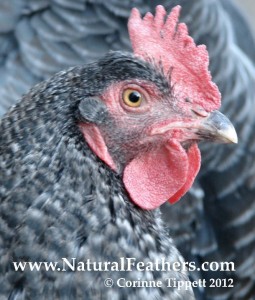
Most birds molt once or twice a year. When buying molted feathers, there are some things to watch out for.
Our perspective on cruelty-free feathers is described on this page of our website… and we know that it doesn’t exactly match the PETA definition, but we don’t completely agree with that definition.
We participate in the circle of life, and feel strongly that when all of us, as a society, participate more fully, we will begin to address issues of food justice. We are doing what we can in the meantime, by raising poultry with conscience and integrity.
Feathers that match the PETA definition of cruelty-free would have to be molted feathers. If you are buying molted feathers, there are some things to know so that you don’t get duped by a seller capitalizing on the cruelty-free movement, but selling feathers raised the conventional way.
First of all, molted feathers are molted for a reason. The bird needs new ones, and sheds the old feathers in a grand exuberance. It is generally in the spring or summer, and the feathers are not of the highest quality. The occasional feather from the molt is good-looking, but more often, they are rough.
Secondly, they are not molted in huge quantities. Otherwise, the bird would be naked. If a seller is selling large numbers of “molted” feathers, I would suspect them. Even if the farmer had a huge flock, collecting the molted feathers one by one would be so prohibitive that I can’t imagine how expensive those feathers would have to be.
Thirdly, the feathers could not, and would not, come in matching and complete sets. The birds never molt an entire matching set of perfectly beautiful feathers. That’s the whole point of a molt. You keep some, you lose some.
Our cruelty-free feathers are good karma, clean, and raised with care. We cherished the birds, and we cherish the feathers… and invite you to take a look!

Martin Hallberg
February 25, 2018 at 6:10 am
Hi, i have raised a lot of birds, and birds take good care of ther feathers, if not, they would frees or not be able to fly, so most feathers ar in realy good shape when they start moulting. Ducks, hens, peafowl, turkeys moult al ther feathers in a couple of months,usualy after mating season in july to oct, then the new ones start to grow so they have new ones when whinter comes, so if they ar collected every day they will be in great shape and in matching sets. One peacock will give u ca 150 eye feathers(tailcower), 20 primary feathers, 20 secondary feathers, 18 tailfeathers and thousands of bodyfeathers every year when it have moulted. I dont kill any of my birds, and i use ther feathers in the masks i do.
admin
February 27, 2018 at 12:24 am
You are so right, thank you for commenting. Our geese and ducks and turkey dropped perfectly gorgeous feathers in their seasonal molt – and our goose feather bags were all from the molt. They are sold out now, but were spectacular. Our turkeys were not as careful with their grooming, so their molt was more hit and miss, but the ducks dropped beauty twice a year. I had a farmer friend with a peahen and her wing feathers – all cleanly molted – were so beautiful I bought them all. My chickens, however, were messy summer molters. I would come to the pen in the morning and it would look like a bird had exploded, and most of the feathers were missing their tips, the best part. But yes, the larger fowl, and the pheasant, molted. Great info! I often don’t approve the comments on the site – even though some of them are pretty funny, if a little spicy… but this comment adds important details to the topic. Thanks again.